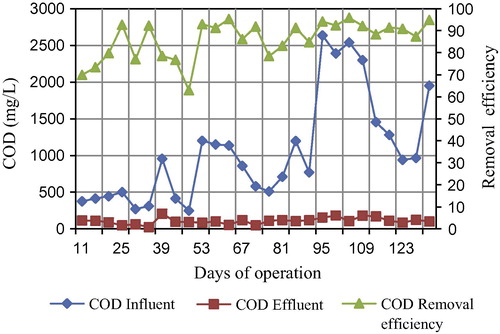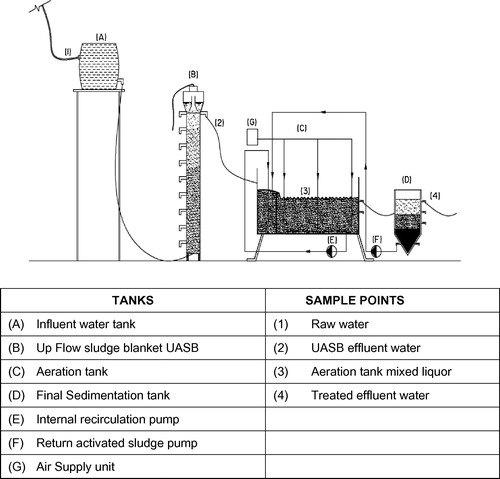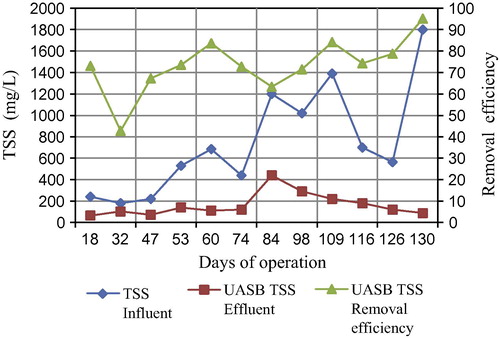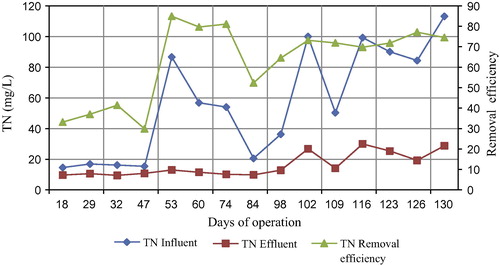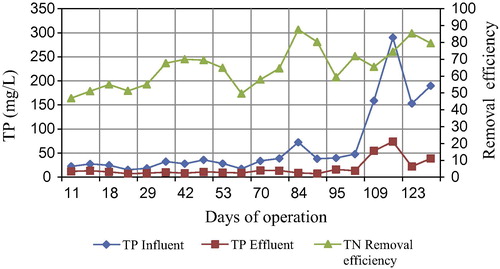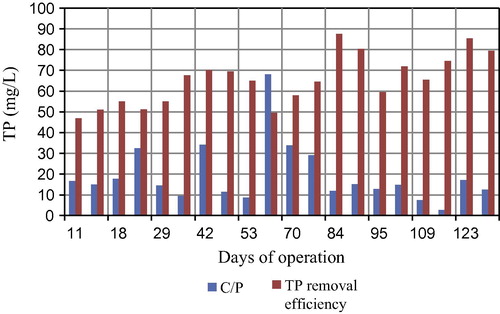Abstract
Feasibility of a combined system consisting of an anaerobic up-flow anaerobic sludge blanket (UASB) followed by anoxic unit then aerobic activated sludge (AS) was investigated.
The system was fed with normal domestic wastewater, then medium loading wastewater using activated sludge from El Berka WWTP, then high strength sewage having a chemical oxygen demand (COD) of 2635 mg COD/L. The organic loading rate (OLR) was increased gradually from 0.5 to 4.43 kg COD/m3/day. The HRT was changed for each loading from 10.5 to 15 h. The internal recirculation (IR) was tested at 100%, 200% and 300% for each loading run. The return activated sludge was adjusted to maintain a mixed liquor suspended solids of greater than 2500 ppm.
At steady state conditions, the UASB reactor achieved removal efficiency up to 79.13% of the total COD. The combined system performed an excellent organic removal pushing the overall removal efficiency of the total COD, TN and TP to 95.87%, 84.95% and 87.59%, respectively.
When the OLR increased to 4.43 kg COD/m3/day, the effluent quality of the UASB deteriorated reaching a percent of 48.20 for COD removal efficiency dropped to 62.90%, 29.90% and 46.90% respectively.
The optimum operational conditions for the system on different organic loadings were HRT = 15 h and the IR = 200%.
Introduction
The purpose of wastewater treatment is to remove pollutants than can affect the aquatic environment if they are to this stream discharged. Wastewater treatment engineers historically focused on the removal of pollutants that would deplete the DO in the receiving water for the deleterious effects of low dissolved oxygen DO concentration on aquatic life.
Most oxygen demanding pollutants are organic compounds; however the ammonia nitrogen is an important inorganic one. Thus early wastewater treatment systems were designed to remove organic matter and to oxidize ammonia nitrogen to nitrate nitrogen, and this is still the goal of many systems built today [Citation1].
Inappropriate discharge of nitrogenous compounds has adverse effects on the aquatic systems such as eutrophication, toxicity to aquatic organisms and depletion of dissolved oxygen in receiving water bodies.
The Current studied system evolves both the anaerobic and then an aerobic systems. The choice of the post treatment method depends on the characteristics of the anaerobic effluent and on the standards set by environmental agencies for direct discharge to the receiving water or reuse of the treated effluent [Citation2]. The advantages of the combination are: (a) lower energy consumption; (b) lower chemical consumption for dewatering; (c) less sludge to be disposed of; (d) less equipment required; (e) higher operational simplicity (f) better sludge dewatering characteristics.
The proposed system is an A2/O process anaerobic, anoxic aerobic replacing the anaerobic unit by high rate UASB. Ammonia will be transformed into nitrite and then nitrate (nitrification) in the aerobic tank and the return supernatant in the aerobic tank will be returned to the anoxic tank to proceed with denitrification.
On the other hand, phosphate is released in the anaerobic tank, and then taken up excessively in the later aerobic tank. Thus, phosphorus and nitrogen removal can be achieved simultaneously in the process.
The objective of this experiment was to evaluate the feasibility and optimal operational parameters for the process treating domestic sewage flows that El Berka Wastewater treatment plant actually receives.
Materials and methods
In this research, an A2/O process was used for the treatment of the domestic wastewater in El Berka wastewater treatment plant replacing the anaerobic unit by UASB reactor. The proposed flow diagram of the system as well as the sample points is shown in .
Model description
Raw domestic wastewater will be collected from the channel connecting grit removal chamber and primary sedimentation tanks in El Berka WWTP by gravity. Raw wastewater is then connected directly to Polyethylene tank of 500 l capacity located at high level to feed the system with raw water, afterward the water flows to the uPVC pipe used as an up flow sludge blanket reactor UASB with a volume of 25.6 l.
Water flows after the UASB to the anoxic unit located in a steel tank with length of 100 cm, Width of 0.45 cm and total depth of 65 cm, the anoxic unit length is about 15 cm, then the aeration unit is 85 cm. The final sedimentation tank is introduced with diameter of 30 cm and total height of 65 cm to collect the aeration tank effluent waters and is connected to a pump (5 l/min) for return sludge.
Another pump with the same capacity is connected to the aeration zone to return nitrate back to the anoxic zone.
Three operational parameters were tested: the organic loading rate (OLR), the hydraulic retention time (HRT) and the internal recirculation (IR) of the flow from the aerated zone to the anoxic zone of the system on three levels as shown in . However, during the system runs, it was affected by all the factors simultaneously.
Table 2 Runs schedule.
The optimization experiments were designed according to the Taguchi fractional design method [Citation3]. This method considers efficiency of COD, BOD, TSS, VSS, NH4-N and NO3-N, TP. A L9 (33) orthogonal array was used in this experimental design [Citation4]. summarizes the test levels implemented for the selected factors.
Table 1 Tested operational parameters and the levels of testing.
The experiment was set on 9 runs on which we test the effect of changing of one of the three parameters on the system performance addressing the best limits for good system operation. shows the 9 runs schedule. And shows the organic loading rate along the experiment duration for the UASB and the activated sludge system afterward.
Fig. 2 The organic loading rate along the experiment duration for the UASB and the activated sludge.
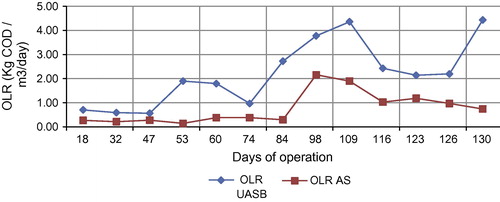
The internal recirculation was adjusted per run and the return activated sludge to the anoxic zone (RAS) was also adjusted to achieve the appropriate mixed liquor suspended solids in the aeration zone.
The aerobic retention time was experimented to determine the least HRT that can achieve the required effluent water quality required by law 48 for the year 1982.
The SRT was controlled to maintain nitrification as the nitrifying autotrophic bacteria have a much slower growth rate than other heterotrophic bacteria. Therefore, doubling of the nitrification microorganism population requires 10–20 times longer than for other heterotrophic bacteria [Citation5].
The DO in the aeration zone was adjusted to 2 < DO < 4 mg/L. Nitrification requires the presence of sufficient DO, and the rate of nitrification can be limited when DO concentration is too low to support a sufficiently high oxygen transfer rate. In municipal activated sludge systems with HRTs of 6–8 h, the nitrification rate is maximized when DO concentration is 2 mg/L or greater [Citation5].
Results
The experiment was started on May, 2014 and terminated on the 1st of October, 2014. The system was run continuously for about 4 months using the raw wastewater of the El Berka WWTP and the high organic loading was achieved by adding activated sludge from the secondary plant clarifiers to achieve the required organic loading rate for each run.
The experiment lasted about 130 days, optimizing the best operational parameter for the system. In order to obtain steady state conditions in the system, the system was operated at least five days before each test condition changes. Three times experiments were conducted continuously at each run.
The evaluation of overall system performance was achieved by the observation and the comparison of the concentrations of the main parameter in the law 48 for the year 1982 variables such as COD, BOD5, TSS, VSS and some operational parameters such as pH, alkalinity, temperature in influent wastewater and effluent from the final sedimentation tank.
The normal domestic wastewater organic loading operation (Runs 1–3)
The first three runs were operated at the normal domestic wastewater loading in El Berka WWTP ranging between 248 and 955 mg/L as total COD. shows the raw water characteristics. The influence of the HRT, and the internal recirculation IR on the COD, TN and TP removal in the proposed system was isolated and obtained.
Table 3 Raw water characteristics during the Low organic loading runs.
The influence of the internal recirculation on the COD, TN and TP removal
The average efficiency of NH4-N removal was about 59.34% for all the three tested values of IR. shows nitrogenous compound efficiency.
Table 4 Low organic loading runs results.
When the IR was increased from 100% to 200% during Run 2, the efficiency of the TN removal increased from 33.17% to 39.21% though the HRT was also increased in Run 2. And on increasing the IR to 300% on the Run 3 the TN removal efficiency dropped to 29.90% which could be attributed to the low HRT in the third run and the high DO concentration reaching the denitrification zone inhibiting the denitrifiers bacteria and the denitrification capacity of the system is decreased. The analysis and result of the orthogonal experiment are shown in .
The total COD removal efficiency of the optimum run in the low loading runs met the required COD effluent water characteristics as per the law 48 for the year 1982, then Decree 8, 1993.
The total phosphorus average removal efficiency during the 1st run ranged between 46.90 and 55.04% achieving the max efficiency of 69.05% when the IR was 300%. This could be attributed to the variation in SRT required by nitrifiers and the Phosphorus removal bacteria. The best SRT for nitrification is usually more than 20 days but for the removal of phosphorus it is 5–8 days, which means it is hard to accomplish high level of P and N in same system concurrently [Citation6].
Another reason is the competition between poly-phosphate bacteria and denitrifying bacteria for the organic carbon sources in the anoxic zone.
The influence of the HRT on the COD, TN and TP removal
The system performance was investigated with hydraulic retention times 10.5, 12.5, 15. shows the average removal efficiency of the NH4-N, TN and COD. The Total nitrogen removal was enhanced on increasing the HRT, while the TP removal was decreased. The best and economical operational conditions that can meet the law 48 for the year 1982 were when the HRT = 12.50 h and the IR = 200%. Though it was not yet able to meet the TN removal limits for the average values of the run which can be caused by the high DO in the aeration tank that was higher than 4.5 mg/L, high concentration of DO simultaneously entered the anoxic tank with the internal recirculation return. This had a bad impact on the condition of anoxic tank, and the activity of denitrifying bacteria was also inhibited.
Table 5 Raw water characteristics during the low organic loading runs.
The medium loading wastewater organic loading operation (Runs 4–6)
The medium loading runs were operated at a wastewater loading ranging between 510 and 1200 mg/L as total COD. shows the raw water characteristics. The influence of the HRT, and the internal recirculation IR on the COD, TN and TP removal in the proposed system was isolated and obtained.
The influence of the internal recirculation on the COD, TN and TP removal
The average efficiency of NH4-N removal was about 74.64% for all the three tested values of IR. shows nitrogenous compound efficiency.
Table 6 Medium organic loading runs results.
When the IR was increased from 200% to 300% during Run 5, the efficiency of the TN removal increased from 82.31% to 81.13%. And on decreasing the IR to 100% on the Run 6 the TN removal efficiency dropped to 52.33% which could be attributed to the low recirculated nitrogen concentration reaching the denitrification zone and the denitrification capacity of the system is decreased. The analysis and result of the orthogonal experiment are shown in .
The total COD removal efficiency of the optimum run in the medium loading runs met the required COD effluent water characteristics for an average value as per the law 48 for the year 1982, then Decree 8, 1993.
The total phosphorus average removal efficiency during the 4th run ranged between 49.58 and 64.91% achieving the max efficiency of 83.95% when the IR was 100%. On the 6th run when the IR was equal to 100% the HRT was increased; consequently the SRT in the system decreased giving a good chance for the PAOs to be dominant in the aeration tank as the nitrifiers were deactivated to some extent due to the low SRT.
The influence of the HRT on the COD, TN and TP removal
The system performance was investigated with hydraulic retention times 10.5, 12.5, 15. shows the average removal efficiency of the NH4-N, TN and COD.
The best and economical operational conditions that can meet the law 48 for the year 1982 were when the HRT = 15 h and the IR = 200%. (Run 5)
The high loading wastewater organic loading operation (Runs 7–9)
The high loading runs were operated at a wastewater loading ranging between 940 and 2635 mg/L as total COD. shows the raw water characteristics. The influence of the HRT, and the internal recirculation IR on the COD, TN and TP removal in the proposed system was isolated and obtained.
Table 7 Raw water characteristics during the low organic loading runs.
The influence of the internal recirculation on the COD, TN and TP removal
The average efficiency of NH4-N removal was about 63.90% for all the three tested values of IR. shows nitrogenous compound efficiency.
Table 8 High organic loading runs results.
When the IR was decreased from 300% to 100% during Run 8, the efficiency of the TN removal increased from 69.90% to 70.85%. And on optimizing the IR to 200% on the Run 9 the TN removal efficiency raised to 74.52% though the HRT was decreased on the Run 9.
The total COD removal efficiency of the optimum run in the high loading runs was not able to meet the required COD effluent water characteristics for an average value as per the law 48 for the year 1982, then Decree 8, 1993.
The total phosphorus average removal efficiency during the 7th run ranged between 59.38 and 71.88% achieving the max efficiency of 82.43% when the IR was 200% at Run 9.
On the 9th run when the IR was equal to 200% the HRT was increased; consequently the SRT in the system decreased giving a good chance for the PAOs to be dominant in the aeration tank as the nitrifiers were deactivated to some extent due to the low SRT.
The high value of the TP in the influent water was due to the inoculation with un-aerated sludge; the anaerobic conditions in the sludge caused a high phosphorus release in the sludge raising the sludge in the influent water.
The influence of the HRT on the COD, TN and TP removal
The system performance was investigated with hydraulic retention times 10.5, 12.5, 15. shows the average removal efficiency of the NH4-N, TN and COD.
The best and economical operational conditions that can give best results were when the HRT = 15 h and the IR = 200% (Run 9).
The TN and TP removal was the highest value during the Run 9, while the COD decreased by only 3% but giving the same results as the Run 9 as the removal efficiency is a ratio between the influent and effluent values. So the Run 9 was chosen to be the optimum run with minimum cost for the whole treatment process.
The overall system efficiency under different organic loading conditions
The system performance reached effluent quality required by law 48 for the year 1982, then Decree 8, 1993 under low and medium organic loading wastewater which is the normal domestic wastewater loads in El Berka WWTP, while achieving the COD effluent quality of the law in higher organic loadings with relatively low effluent TN & TP concentrations. The following section discusses the overall system performance of the experiment.
The influence of the organic loading on the COD removal efficiency
The system overall COD removal efficiency ranged between 62.90 and 95.87%. The COD removal versus the organic loading rate is shown in Figs. –. Of this COD removal, a percent of about 52.70 COD was removed from solution in the anaerobic zone, while 16.74–45.56% COD removal was obtained in the oxic zone.
The UASB overall efficiency during the experiment ranged between 48.20 and 79.13%. High biomass washout occurred in UASB between days 95 and 130 (high loadings runs) due to increase of the OLR and as a consequence the average total COD removal efficiency in this period decreased to 65.63 ± 12.50%. shows the UASB effluent TSS along the experiment.
The influence of the organic loading on the TN removal efficiency
The TN removal efficiency increased on increasing the organic loading rate as the heterotrophic denitrifiers metabolize readily biodegradable substrate under anoxic conditions using nitrate as the electron acceptor. A readily biodegradable carbon source must be available for denitrifiers to use.
But on increasing the organic loading to more than 1500 as COD mg/L the large amount of microorganism is required in the aerated mixed liquor to metabolize readily biodegradable substrate under anoxic conditions, then in the aeration tank the F/M should be adjusted to no more than 1.5. Consequently when the loading rate increased in the system the TN removal efficiency decreased. shows the TN removal along the experiment duration.
The influence of the organic loading on the TP removal efficiency
The system could achieve the required limits of effluent TP for the low and medium organic loading rates. shows the TP removal along the experiment duration; however the effluent total phosphorus in the high organic loading runs ranged between 4.5 and 24.67 mg/L. shows the variation of phosphorus concentration with C/P feeding ratio in the process. It can be observed that when the C/P feeding ratio was lower than 30, phosphorus removal efficiency increased as C/P ratio increased linearly, and P removal efficiency was as high as 57.59% at the C/P ratio of 11.83.
When the C/P feeding ratio was higher than 32, the P removal efficiency was maintained at 49.50–51.30%, and effluent P concentration was lower than (7.5–8.9) mg/L. It is apparent that the value of 30 for C/P ratio was the boundary between COD limiting and P limiting conditions in this system.
The system TP, TN removal efficiency was higher than that reported by Campos et al [Citation7], however the COD in effluent water in the system was higher but still can meet the law 48 for the year 1982 requirements in the low and medium organic loading operation conditions.
Conclusions
The results have shown that the proposed system has a great potential to replace existing conventional activated sludge systems for municipal wastewater treatment in sub-tropical and tropical regions for example Egypt. The cost of treating municipal wastewater could be potentially reduced using the UASB produced biogas, reduction of aeration requirements and decrease in the amount of sludge needed to be disposed of. The UASB has no mechanical equipments and there is no need for primary sedimentation and sludge thickeners, and low sludge production with good settling properties.
The excellent removal of solids in the aerobic process is guaranteed, even in scenarios where the biological flocculation is deficient (bulking, high organic loadings for example). The UASB reactor had low TSS and TCOD removal efficiencies; the overall system was capable of meeting secondary-effluent water quality requirements with an overall HRT of at least 12.5 h.
The effluent sludge can be directly sent to dewatering, or, alternatively, to the anaerobic reactors where it will be submitted to complementary digestion.
At a HRT of less than 3.5 h and high organic loading rates during the Runs 7–9, the UASB achieved lower SS and VSS removal efficiencies than in the low and medium loading runs, due to period washouts of bio-solids.
An accumulation rate of 49.40 g TSS/day was observed in the UASB unit. During the low loading run which is the normal domestic sewage characteristic, this low accumulation rate would allow operating the UASB reactor without sludge wasting for extended periods around 5 months.
Conflict of Interest
There is no conflict of interest.
Notes
Peer review under responsibility of Housing and Building National Research Center.
References
- C.P.Lesile GradyJr.Glen T.Diagger,Nancy G.LoveCarlos D.M.FilipeBiological Wastewater Treatmentthird ed.2011IWA publishing
- K.Kujawa-RoeleveldG.ZeemanAnaerobic treatment in decentralized and source-separation-based sanitation conceptsRev. Environ. Sci. Biotechnol.512006115139
- A.Ghani.JaharahHarisJamaluddinMohd Nizam AbRahmanBaba MdDerosPhilosophy of Taguchi approach and method in design of experimentAsian J. Sci. Res.620132737
- L.R.MasonF.R.GunstL.J.HessStatistical Design and Analysis of Experimentssecond ed.2003John Wiley & SonsNew York
- Water Environment Federation (WEF) and American Society of Civil Engineers (ASCE)/Environmental and Water Resources Institute (EWRI)Biological Nutrient Removal (BNR) Operation in Wastewater Treatment Plants2006McGraw HillNew York
- J.YUS.ZHOUNitrogen removal efficiency of an A2O bio-reactor treating domestic sewage mixed with landfill leachate and fecal sewageGlobal NEST J.2010181189
- J.R.CamposM.A.P.RealiR.RossettoJ.SampaioA wastewater treatment plant composed of UASB reactors activated sludge with DAF and UV disinfectionWater Pract. Technol.200918

